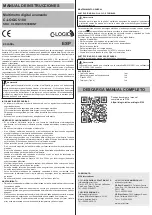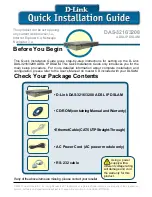
5
4.5 RESISTANCE
Ω
There are six ranges for measuring resistance 200, 2K, 20K, 200K, 2 M, and 20Meg Ohms. For more accurate measurements use the lowest range
possible without exceeding the setting value. When measuring resistance always make sure the power to the circuit is off.
1. Set the function/range switch to the appropriate resistance setting to measure
Ω
(ohms).
2. Insert the black (negative) test lead into the COM input terminal.
3. Insert the red (positive) test lead into the V
Ω
input terminal.
4. Touch the test leads to the resistor or non-energized component to be measured. Use the 20 M Ohm range when testing for resistance
values in electronic components such as resistors and potentiometers. If the value of the component falls within the range of a lower setting,
reset the function/range switch to that setting for a more accurate reading.
5. Read the value of the measurement displayed. With resistance measurements, the polarity of the test leads is not a factor.
6. Typical resistance/continuity measurements include resistors, potentiometers, switches, extension cords and fuses.
4.6 CONTINUITY
To avoid damages to the Meter or to the devices under test, disconnect circuit power and discharge
all the high-voltage capacitors before measuring resistance.
Do not input 60V DC or 30V AC to avoid personal harm. Do not use on energized circuits.
1. Insert the red test lead into V
Ω
terminal and the black test lead into the COM terminal.
2. Set the function switch to
3. Connect the test leads across with the object being measured.
4. The buzzer sounds continuously if the resistance of a circuit under test is°‹10
Ω
, it indicates the circuit is in good connection.
5. The buzzer does not sound if the resistance of a circuit under test is°100
Ω
, it indicates a possible broken circuit.
6. Read the resistance value on the display.
Note: Open circuit voltage is around 3V.
4.7 DIODE TESTING
Use the diode test to check diodes, transistors, and other semiconductor devices. The diode test sends a current through the semiconductor junction,
and then measures the voltage drop across the junction. A good silicon junction drops between 0.5V and 0.8V.
To test out a diode while removed from a circuit, connect the Meter as below:
1. Insert the black (negative) test lead into the COM input terminal.
2. Insert the red (positive) test lead into the V
Ω
input terminal.
3. Set the function switch to diode position “
”
4. For forward voltage drop readings on any semiconductor component, place the red test lead on the component’s anode and place the
black test lead on the component’s cathode.
5. Read the nearest value of the diode’s forward voltage drop as displayed.
Notes
• In a circuit, a good diode should still produce a forward voltage drop reading of 0.5V to 0.8V; however;
the reverse voltage drop reading can vary depending on the resistance of other pathways between the probe tips.
• Connect the test leads to the proper terminals as in figure above to avoid error display.
The LCD displays OL indicating open-circuit for improper connection.
• Open circuit voltage is approximately 3V.
5.0 HOUSEHOLD BATTERY TESTING
There are two ranges for measuring common household batteries, 1.5 V and 9 V.
1. Insert the black (negative) test lead into the COM input terminal.
2. Insert the red (positive) test lead into the V terminal.
3. Set the function/range switch to the appropriate battery position.
4. Touch the test leads to the positive and negative terminals on the battery. With DC voltage, the polarity of the test leads is a factor.
Touch the black (common) test lead to the negative (-) terminal and the red test lead to the positive (+) terminal.
5. Read the value of the measurement displayed. If the leads are reversed a “-” indicator will appear on the display.
6.0 BATTERY REPLACEMENT
To avoid false readings, which could lead to possible electric shock or personal injury, replace the battery as soon
as the battery indicator appears
1. Disconnect the connection between the test leads and the circuit under test, and remove the test leads from the input terminals of the meter.
2. Turn the Meter power off.
3. Remove the rubber boot from the meter.
4. Remove the 3 screws from the case, and separate the case top from the case bottom.
5. Take the back cover off and turn the back cover over.
6. You’ll see a spot to place a 9 volt battery at the top of the back cover and it should only fit one way unless you force it.
This is supposed to indicate the polarity of the battery along with a plus and minus symbol, but sometimes this is covered up by a security tag.
7. Replace with one fresh 9 volt battery (NEDA 1604 6F22 006P)
Note: Do not use rechargeable batteries in this unit.
8. Carefully replace the battery cover and tighten the 3 screws. Do not overtighten the screws as this may strip the threads in the meter housing.
























